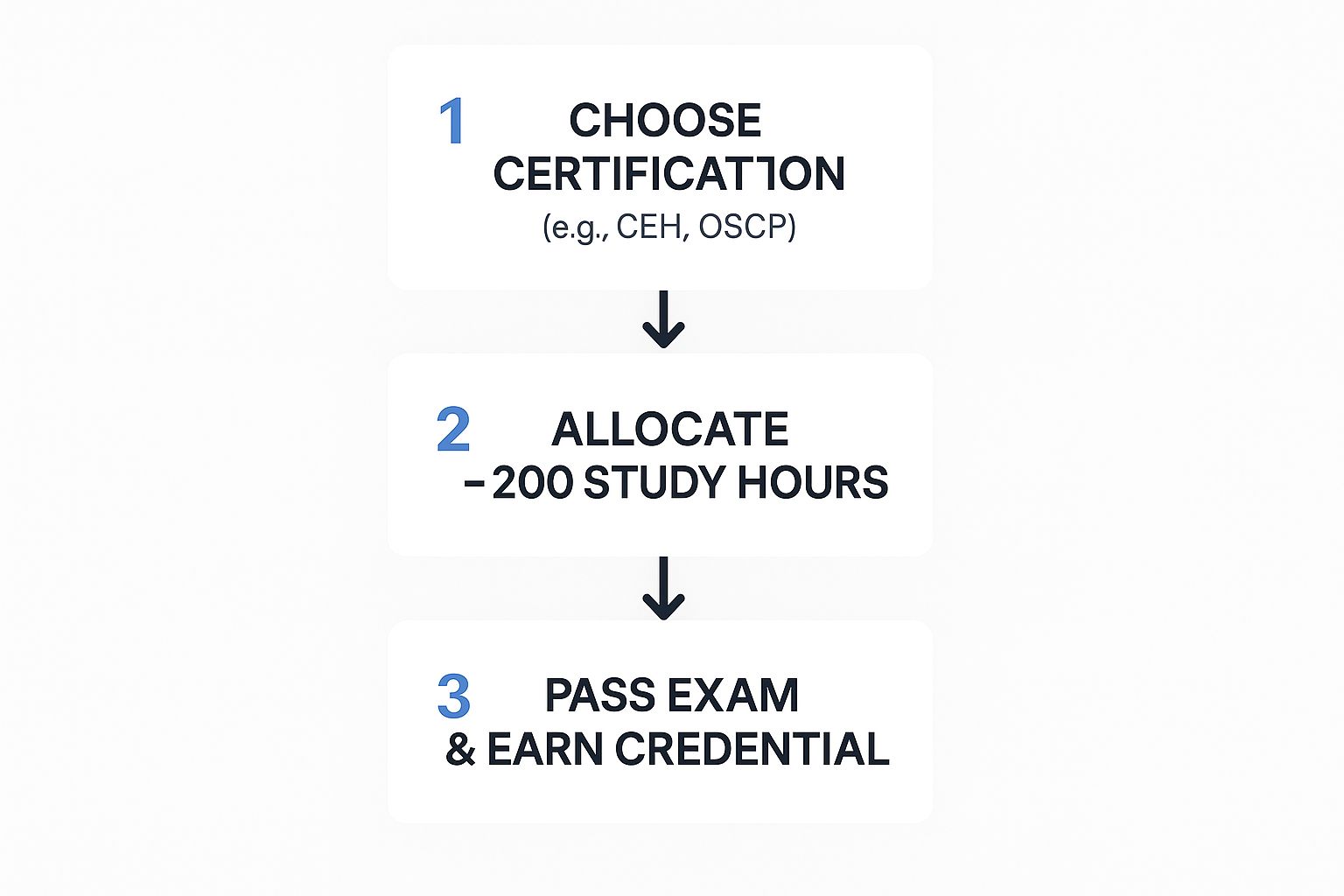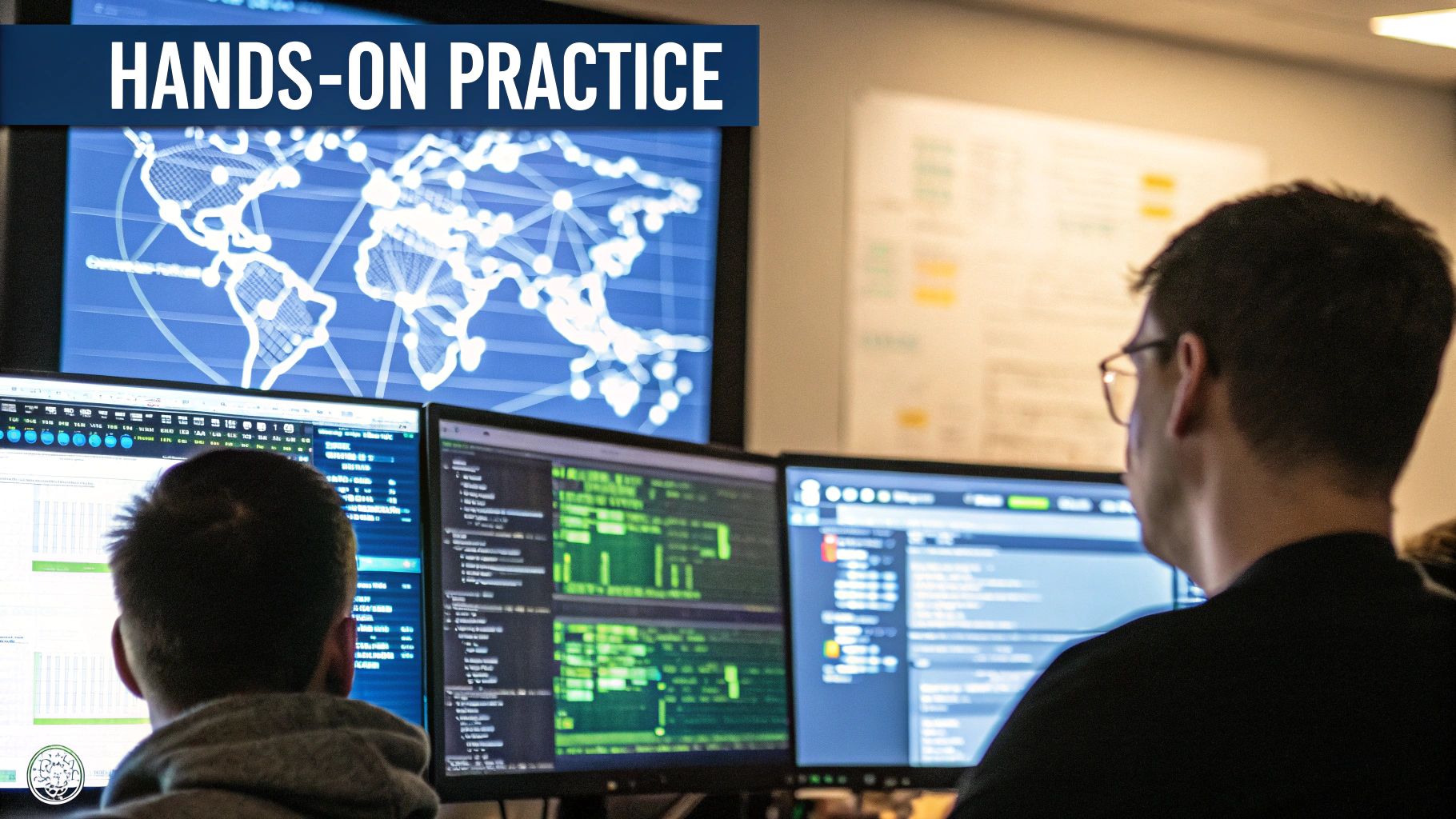So, you want to become a penetration tester? It's a straightforward path, but don't mistake "straightforward" for "easy." It all boils down to building a rock-solid technical foundation, getting your hands dirty in lab environments, and proving your skills with respected certs like the OSCP. This isn't some black magic, it's a technical discipline that demands serious, hands-on work.
What It Really Takes to Become a Penetration Tester
Forget the Hollywood stereotype of a hacker hunched over a keyboard in a dark room. For an MSP or a vCISO, understanding what makes a great pentester is a massive strategic advantage. You need to know what real skill looks like so you can deliver credible, high-impact security services to your clients.
Then the business logic behind pentesting; often times we see pentesters who are incredibly smart but can't comprehend that an SMB business does not want nor need to be as secure as a safety critical infrastructure of a SP 500 company.
The truth is, the industry is starving for skilled, US Based manual pentesting talent. Too many MSPs hit a wall here. They're stuck choosing between overpriced firms with bloated overhead or slow, unresponsive teams that bring critical projects to a screeching halt. That gap is your opportunity, whether you're building an in-house team or looking for a solid reseller partner.
Why This Matters for Your Business
A strong pentesting capability isn't just another line item on your services sheet; it's the solution to your clients' biggest compliance nightmares.
- Data Compliance Demands: Clients staring down ISO 27001 or PCI DSS requirements can't just check a box with an automated scanner. They need thorough, manual testing to prove they’ve actually done their due diligence.
- Building Real Trust: Offering legitimate pentesting rather than another automated scanner like Horizon3, Vonahi, etc transforms you from a simple IT provider into a true security advisor. This deepens client relationships and makes you indispensable.
- Finding the Right Partner: If building your own team isn't in the cards, you need a white label pentesting partner who understands the channel. You need someone fast, affordable, and who will never try to poach your clients.
The demand for skilled pentesters isn't just industry buzz; it’s a full-blown global talent crisis. In 2022, there were nearly 600,000 open cybersecurity jobs worldwide, with only 68% of them filled. That gap is projected to explode to 3.5 million unfilled roles by 2025, making skilled testers worth their weight in gold. Learn more about the cybersecurity skills gap.
This guide is designed to cut through the noise. We're laying out the real-world roadmap to becoming a penetration tester, giving you the insights to either grow your own talent or find a partner who meets the high standards your clients expect. This is about more than a career path—it's about building a security capability that protects your clients and grows your business.
Building Your Technical Foundation

You can't exploit what you don't understand. A career in pentesting isn't built on flashy tools and a cool hoodie; it's built on a rock-solid technical foundation. This is where the real work begins.
For any vCISO or MSP vetting talent for manual pentesting gigs, this is the absolute baseline.
Think of it like being a master mechanic. You wouldn't trust someone who only knows how to plug in a diagnostic scanner but can't explain how an engine actually works. Same logic applies here. Tools find symptoms, but a real understanding lets you diagnose the root cause and find your way in.
Mastering Networks and Operating Systems
At its core, pentesting is about knowing how systems talk to each other and how they work. You have to know the rules before you can break them. That means getting intimately familiar with the building blocks of any IT environment.
- Networking Protocols: You need to live and breathe TCP/IP. Understanding how packets are routed, what a three-way handshake actually is, and how protocols like DNS and DHCP function is non-negotiable. This is how you spot weak network configurations.
- Operating System Internals: Get comfortable in the command line of both Linux and Windows. You should be able to navigate file systems, manage processes, and understand user permissions without a GUI. This is fundamental for post-exploitation and privilege escalation.
A huge part of this is grasping the "why" behind the security controls. Why does a firewall block certain ports? How does a router decide where to send traffic? When you understand the intended design, you can spot the flaws.
The goal isn't just to use a tool that tells you a port is open. It's to understand what service is on that port, why it's configured that way, and how you can abuse it to get a foothold. That’s what separates a script kiddie from a pro.
The Power of Scripting and Automation
While manual testing is our bread and butter, no serious pentester does everything by hand. The ability to automate repetitive tasks is a massive force multiplier. It frees you up to focus on the creative, human-driven parts of the job.
This is where scripting comes in.
Learning a language like Python or Bash isn't optional anymore. It's a core skill that lets you build custom tools, parse huge amounts of data from recon scans, and automate parts of the exploitation process.
For an MSP or reseller looking for a white label pentesting partner, this skill shows a higher level of maturity and efficiency. A team that can script can deliver more thorough and affordable results, faster.
For instance, you might write a simple Python script to:
- Take a list of subdomains from recon.
- Run a specific Nmap scan against each one.
- Parse the output to find open web ports.
- Feed those results into a web directory brute-forcing tool.
You just can't get that kind of custom workflow with off-the-shelf tools alone. It’s essential for effective compliance-focused testing required for frameworks like SOC 2 and HIPAA.
This foundational knowledge is also the first step in a solid vulnerability management program. To build on this, check out our guide on effective threat and vulnerability management. Ultimately, these fundamentals ensure you can adapt to any environment and find the vulnerabilities that automated scanners will always miss.
Choosing Certifications That Actually Open Doors
The cybersecurity world is a confusing alphabet soup of certifications. It’s hard enough for us in the industry, let alone an MSP or vCISO trying to figure out which acronyms actually signal competence.
Only a handful of these certs really prove someone has the chops for high-quality, manual pentesting—the kind your clients absolutely need to satisfy serious compliance frameworks.
Think of certifications as a driver's license. They prove you know the rules of the road, but they don't mean you can win a Formula 1 race. For an MSP looking to hire or partner, focusing on the right certs is a great first filter to find real talent. It’s a starting point, not the finish line.

As you can see, earning a respected cert isn't a weekend project. It often involves hundreds of hours of dedicated study before even attempting the exam.
The Foundational Certs: Building the Base
You have to walk before you can run. In pentesting, foundational certs prove a candidate has grasped the core concepts of IT and security. They aren't pentesting certs themselves, but they lay the essential groundwork.
Without this baseline, a tester only knows that an exploit works, not why. That's a critical distinction.
- CompTIA Security+: This is pretty much the universal starting point. It covers the essentials from cryptography and identity management to network security and risk management. For any junior role, this is often a non-negotiable prerequisite.
While many aspiring pentesters have college degrees—industry data shows 65% hold at least a bachelor's—it’s the certifications that truly validate hands-on skills in this field. Certs like CEH, OSCP, and Security+ are constantly cited as crucial for getting a foot in the door. You can discover more insights about pentesting career paths on cybersecurityguide.org.
The Practical Certs: Where Hands-On Skills Are Proven
This is where the rubber meets the road. These certs aren't about memorizing facts for a multiple-choice test; they require candidates to actually break into systems in a lab environment. They are highly respected because they prove ability, not just knowledge.
If a candidate has one of these, a reseller or vCISO knows they can actually execute.
- Offensive Security Certified Professional (OSCP): The OSCP is the gold standard for a reason. It’s a grueling 24-hour exam where you have to compromise multiple machines in a live lab and then write a professional report. No multiple-choice questions here. You either get in, or you don't.
- Certified Ethical Hacker (CEH): The CEH is incredibly well-known and often a filter used by HR departments. While the standard version is multiple-choice, the CEH (Practical) is a hands-on exam that gives a much stronger signal of a candidate's real-world skills.
An OSCP certification tells a hiring manager one thing loud and clear: this person can think like an attacker and has the persistence to overcome challenges. It's less about the specific tools and more about the mindset, which is exactly what you need for effective manual pentesting.
Let's break down how these top-tier certifications stack up against each other. Each one serves a slightly different purpose and is ideal for different stages of a pentester's career.
Key Pentesting Certifications Breakdown
Ultimately, a strong pentesting team—whether you build it in-house or find a great white label pentesting partner—will have a mix of these certifications backed by deep, practical experience.
Certs get you in the door, but a track record of finding and reporting vulnerabilities is what really counts. As an MSP, focusing on partners with these hands-on credentials ensures you're getting an affordable, high-quality service that meets the demands of frameworks like SOC 2 and HIPAA.
Mastering the Essential Pentesting Toolkit

A pentester’s mind is their deadliest weapon, but the right toolkit makes the work possible. Moving from theory to action means getting your hands on the software you'll be using every single day. This isn't just a shopping list; it’s about knowing how each tool fits into a modern, manual pentesting workflow.
The real skill is knowing which tool to grab for the job and how to make sense of what it spits out. For any MSP or vCISO vetting a pentesting partner, this is a huge differentiator. A good team doesn't just run automated scans and hand you a PDF. They use tools to gather intel, then apply human creativity to find the real business risks.
Network Reconnaissance and Vulnerability Scanning
Before you can attack a target, you have to map it out. This is where you build a picture of the environment, figuring out what hosts are live, what ports are open, and what services are running. It's the foundation of any solid pentest.
- Nmap (Network Mapper): This is the undisputed king of network discovery. It's an open-source tool used to find hosts and services by sending packets and analyzing what comes back. A well-crafted Nmap scan can reveal a treasure trove of information about a target's architecture.
- Nessus: While Nmap tells you what's there, Nessus helps you understand what's vulnerable. It’s a beast of a scanner that checks systems against a massive database of known exploits and misconfigurations. An MSP can use these scans for a quick baseline, but a true pentester treats the findings as a starting point for deeper, manual validation.
These tools are fantastic for finding low-hanging fruit—the obvious unpatched software and lazy configurations. But they are just the beginning of the story.
The output from Nmap and Nessus isn't the final report; it's the mission briefing. It tells you where to focus your manual efforts to find the vulnerabilities that automated tools always miss, which is critical for compliance frameworks like SOC 2 and HIPAA.
Web Application Analysis and Exploitation
Web applications are one of the biggest attack surfaces for any organization. This is where tools that can intercept, manipulate, and analyze web traffic become non-negotiable. They let you see exactly how an application works and find the flaws in its logic.
Understanding how to exploit web vulnerabilities is a core skill for anyone learning how to become a penetration tester.
For a deeper dive, check out our guide on the top web application security testing tools.
Key Web Pentesting Tools
ToolPrimary FunctionWhy It's EssentialBurp SuiteAn intercepting web proxy.Lets you capture and modify traffic between your browser and the server. It's indispensable for finding flaws like SQL injection and XSS.OWASP ZAPAn open-source web application security scanner.A great, free alternative to Burp Suite that helps automate finding common web vulnerabilities.
Exploitation Frameworks
Once you've found a vulnerability, the next step is to exploit it. Exploitation frameworks are basically toolkits full of pre-built exploit code that help you gain access to a system.
Metasploit Framework is the most famous tool in this space. It’s a massive database of exploits, payloads, and other modules that dramatically simplifies the process of compromising a vulnerable system. For a vCISO or reseller looking for a white label pentesting partner, proficiency with Metasploit is a good sign. But it’s the ability to go beyond its automated features that signals real expertise.
Ultimately, tools are just force multipliers. They point you to potential entry points, but it takes a skilled tester to chain vulnerabilities, bypass defenses, and uncover the complex business logic flaws that automated scans are blind to. This human-driven, manual pentesting approach is what delivers an affordable, high-impact result every time.
How to Gain Hands-On Pentesting Experience

Certifications and knowing your tools might get you an interview, but hands-on experience is what actually lands you the job. This is where you stop reading tutorials and start doing. You have to prove you can apply your knowledge in the real world, not just a clean, predictable exam environment.
If you're an MSP or a vCISO, this is your guide to spotting real talent. When you need a white label pentesting partner or a new hire, you want to see a portfolio of practical work, not just a list of credentials. This is what separates a box-checker from a true security pro who can handle complex manual pentesting.
Build Your Own Home Lab
This is the most critical first step. Seriously. Building your own home lab is your personal sandbox to break things, test exploits, and see how systems talk to each other without any legal or ethical blowback. It doesn't have to be some expensive server rack either—you can get rolling with free virtualization software like VirtualBox or VMware.
Your lab should be a small-scale version of a real corporate network. Spin up a few virtual machines:
- Your Attacker Box: Install Kali Linux or Parrot OS. They come loaded with all the pentesting tools you'll need.
- Vulnerable Targets: Grab intentionally vulnerable VMs like Metasploitable 2 or download some systems from VulnHub. These are built to be hacked.
- A Windows Machine: You absolutely have to learn your way around Windows environments. It's non-negotiable for real-world gigs.
This is where you'll really learn how to become a penetration tester. It's in the late hours spent figuring out why an exploit failed and developing the stubborn persistence that every good tester needs.
Compete in Capture The Flag Events
Capture The Flag (CTF) competitions are basically gamified hacking. They're an amazing way to sharpen your skills on specific challenges in areas like web exploitation, reverse engineering, and cryptography. More importantly, they teach you how to think on your feet under pressure.
Platforms like Hack The Box and TryHackMe are goldmines. They offer a constant stream of CTF-style challenges, from beginner-friendly boxes to ridiculously hard machines that will humble even seasoned professionals. Getting involved in these shows initiative and a real passion for security—a huge plus for any hiring manager.
When you pop a tough box on Hack The Box, you're not just grabbing a flag. You're building a problem-solving methodology, learning to document your steps, and proving you have the grit to see a problem through to the end.
Dive Into Bug Bounty Programs
Once you feel confident in your lab, it’s time to test your skills against live targets—legally. Bug bounty programs, hosted on platforms like HackerOne and Bugcrowd, let you hack real companies and get paid for the vulnerabilities you uncover. This is as close as you can get to real-world pentesting without a contract.
Don't go in expecting to find a critical Remote Code Execution bug on day one. Start small. Hunt for lower-hanging fruit like Cross-Site Scripting (XSS) or simple misconfigurations. The real goal here is to learn how to identify, validate, and professionally report your findings.
A single, well-written bug bounty report can be a powerful piece for your portfolio. It shows off your technical skills and, just as importantly, your ability to communicate complex issues clearly. You can get a feel for professional reporting by checking out our penetration testing report template.
The experience you build here directly impacts your career and earning potential. An entry-level penetration tester in the U.S. earns around $90,500 a year, but with a few years of this kind of hands-on work, that number jumps to over $114,000. Senior testers can pull in well over $130,000.
For any reseller or vCISO looking at candidates, a history of CTF wins and responsible bug bounty disclosures is a clear signal. It means they have the battle-tested skills to deliver an affordable and effective pentest that will satisfy tough compliance requirements like SOC 2 or HIPAA.
Your Pentesting Questions, Answered
We talk to MSP and reseller partners all day, and the same questions about the world of pentesting pop up again and again. It's a complicated field, no doubt.
Getting the right answers helps you screen potential hires, pick the right partners, and ultimately, get better security results for your clients. Here are the straight-up answers to the questions we hear most.
Do You Really Need a CS Degree to Be a Penetration Tester?
No. While a computer science or cybersecurity degree gives you a solid starting point, what truly matters in this game is proven, hands-on skill. This industry values what you can do way more than a piece of paper.
This is why certifications like the OSCP are so respected—they’re brutal, practical exams. Passing one proves you can actually perform in a real-world scenario, which speaks volumes to a hiring manager. When an MSP is vetting talent, forget the GPA. Ask to see their Hack The Box profile or have them walk you through a bug bounty report they wrote. Practical skill beats a diploma every single time.
How Long Does It Take to Become a Pentester?
There’s no magic number. It all comes down to where you're starting from and how hungry you are.
- Coming from a non-technical background? Plan on 1-2 years just to build the core IT knowledge—networking, operating systems, the absolute basics.
- Once you have the foundation? Expect another 1-2 years of dedicated, focused study and lab time to get job-ready.
- Pivoting from an IT role? If you're already an experienced sysadmin or developer, you could make the jump to a junior pentesting role in under a year with intense, focused effort.
The real key is consistency. It's about putting in the hours every single week in the lab, not just cramming for an exam. This is a marathon, not a sprint.
The fastest way to become a pentester isn't a specific course; it's an obsession with breaking things and figuring out how they work. The people who make it are the ones who are constantly practicing, even when no one's watching.
What's the Difference Between Manual and Automated Pentesting?
For any vCISO or MSP, this is the single most important thing to get right. Messing this up leads to failed audits and a dangerously false sense of security for your clients.
Automated scanners are fast. They’re great at finding the obvious stuff—the known vulnerabilities and common server misconfigurations. Think of them as a baseline check, but they are absolutely not a real pentest.
Manual pentesting is done by a skilled human who thinks like an actual attacker. It’s critical because a person can:
- Find complex business logic flaws that automated tools are completely blind to.
- Chain together several low-risk vulnerabilities to create a critical path for a breach.
- Provide the business context and risk analysis that automated reports just can't deliver.
When it comes to serious compliance frameworks like SOC 2 or HIPAA, a real manual pentesting engagement is non-negotiable. Don’t let a vendor tell you their scanner is good enough. It isn’t.
Can I Learn Pentesting on My Own?
You absolutely can. Many of the sharpest pentesters out there are largely self-taught. The resources available today are incredible. Platforms like Hack The Box and TryHackMe offer endless chances to practice in realistic lab environments.
That said, a hybrid approach is usually the most effective. Use structured courses and certification paths to create a roadmap and prove your skills to employers. But spend the bulk of your time getting your hands dirty in the labs.
For our reseller partners, this is the culture you want to look for in a white label pentesting team. You want a team built on constant, practical learning, not just collecting certificates. That’s what makes an affordable and effective service possible.
At MSP Pentesting, we're your channel-only partner. We're committed to providing fast, affordable, and high-quality manual pentests that you can sell under your own brand. We never sell direct, so you can build trust and deliver the security your clients are asking for.


.avif)
.png)